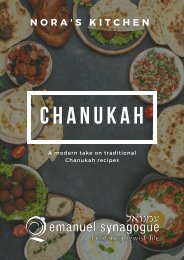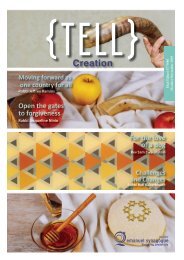You also want an ePaper? Increase the reach of your titles
YUMPU automatically turns print PDFs into web optimized ePapers that Google loves.
N O R A ' S K I T C H E N<br />
h i g h<br />
h o l y<br />
d a y s<br />
m e n u<br />
A modern take on traditional High<br />
Holy Days recipes
N O R A ' S K I T C H E N<br />
H I G H H O L Y D A Y S M E N U<br />
Selection of Dips<br />
Rosh Hashanah Challah<br />
Matzo Ball Soup<br />
Gefilte Fish<br />
Moroccan Carrot Salad<br />
Katja's Herring Salad<br />
Potato Latkes<br />
Kale Salad with Apples & Toasted<br />
Almonds<br />
High Holy Day Fish (also known as<br />
Shabbat Fish)<br />
Honey Cake<br />
Apple Fritter Cake
L E T ' S G E T D I P P I N G !<br />
Dipping apples in honey is not the only dipping we do during the High Holy Days!<br />
Try these simple yet delicious dips to liven up your gastronomic spread!<br />
If you have cannellini beans, olive oil, and a lemon in your kitchen, you’re well<br />
on your way to making this white bean dip recipe. It comes together in<br />
White Bean Dip<br />
seconds in the bowl of a food processor, and it’s absolutely delicious. Lemon<br />
juice and zest fill it with bright flavour, olive oil adds richness, and the white<br />
beans blend into smooth and creamy perfection.<br />
1 + 1/2 cups cooked cannellini<br />
beans, drained and rinsed<br />
What you need<br />
2 tablespoons extra virgin Olive oil<br />
2 tablespoons fresh lemon juice<br />
1/2 teaspoon lemon zest<br />
1 small garlic clove<br />
1/2 teaspoon sea salt<br />
freshly ground black pepper<br />
2 to 4 tablespoons water, if needed<br />
2 tablespoons torn fresh basil leaves<br />
In a food processor, pulse the cannellini beans, olive oil,<br />
lemon juice and zest, garlic, salt, and pepper until<br />
Directions<br />
combined. With the food processor running, slowly add the<br />
water and process until smooth. Blend in the fresh herbs, if<br />
desired. Serve with veggies or pita.
Hummus<br />
1½ cups cooked chickpeas, drained<br />
and rinsed<br />
What you need<br />
⅓ cup smooth tahini*<br />
2 tablespoons extra virgin olive oil<br />
2 tablespoons fresh lemon juice,<br />
more to taste<br />
1 garlic clove<br />
½ teaspoon sea salt<br />
5 tablespoons water, or as needed<br />
to blend<br />
Paprika, red pepper flakes, or<br />
parsley, for garnish<br />
Warm pita bread and/or veggies,<br />
for serving.<br />
In a high-speed blender, place the chickpeas, tahini olive oil,<br />
lemon juice, garlic, and salt. Use the blender to blend until<br />
Directions<br />
very smooth, adding water as needed to blend, and/or to<br />
reach your desired consistency.<br />
Transfer to a serving plate, top with desired garnishes and<br />
serve with warm pita and veggies, as desired.
Guacamole<br />
2 tbsp finely chopped white onion<br />
(or red, brown or yellow)<br />
What you need<br />
1 tbsp finely chopped jalapeno or<br />
serrano chilli (or other chilli of<br />
choice)<br />
1/2 tsp salt<br />
1/4 cup roughly chopped coriander<br />
2 medium avocados<br />
Lime juice<br />
Place the onion, jalapeño, salt and half the coriander on a<br />
cutting board and use a fork to mash until juicy. OR do this<br />
Directions<br />
in a mortar and pestle – grind into a paste.<br />
Scrape into a bowl, add avocado and remaining coriander,<br />
and mash to desired consistency.<br />
Do a taste test then adjust to your taste: salt, lime juice for<br />
sour, more chilli for spiciness.<br />
Put in an airtight container, smooth top and cover with thin<br />
layer of water OR olive oil. Avo is so dense, the water<br />
doesn’t get absorbed at all. Your dip will stay beautifully<br />
green for two days.
R O S H H A S H A N A H<br />
C H A L L A H<br />
What you need<br />
1 1/2 cups lukewarm water, divided<br />
1/4 oz active dry yeast (1 packet)<br />
Dough ingredients<br />
1 tsp sugar<br />
1 large egg<br />
3 large egg yolks<br />
3/4 cup honey<br />
2 tbsp canola oil<br />
2 tsp vanilla<br />
2 tsp salt<br />
5-7 cups flour<br />
3 medium granny smith apples<br />
1/4 cup sugar<br />
2 tbsp turbinado sugar (optional)<br />
wash ingredients<br />
Egg<br />
1 large egg<br />
1 tbsp cold water<br />
1/2 tsp salt
Pour ¼ cup of the lukewarm water (about 110 degrees) into a large<br />
Directions<br />
mixing bowl. Add 1 packet of Active Dry Yeast and 1 tsp of sugar to<br />
the bowl, whisk to dissolve. Wait 10 minutes. The yeast should have<br />
activated, meaning it will look expanded and foamy. If it doesn’t, your<br />
yeast may have expired, which means your bread won’t rise—go buy<br />
some fresh yeast!<br />
Once your yeast has activated, add remaining 1 ¼ cup lukewarm<br />
water to the bowl along with the egg, egg yolks, honey, canola oil,<br />
vanilla and salt. Use a whisk to thoroughly blend the ingredients<br />
together.<br />
Begin adding the flour to the bowl by half-cupfuls, stirring with a<br />
large spoon each time flour is added. When mixture becomes too<br />
thick to stir, use your hands to knead.<br />
Continue to add flour and knead the dough until it’s smooth, elastic,<br />
and not sticky. The amount of flour you will need to achieve this<br />
texture varies—only add flour until the dough feels pliable and “right.”<br />
Turn the dough out onto a smooth surface and knead a few more<br />
times.<br />
Place a saucepan full of water on the stove to boil.<br />
Wash out the mixing bowl that you used to mix the challah dough.<br />
Grease the bowl with canola oil. Push the dough back into the bottom<br />
of the bowl, then flip it over so that both sides are slightly moistened<br />
by the oil.<br />
Cover the bowl with a clean, damp kitchen towel. Place the bowl of<br />
dough on the middle rack of your oven. Take the saucepan full of<br />
boiling water and place it below the rack where your dough sits.<br />
Close the oven, but do not turn it on. The pan of hot water will create<br />
a warm, moist environment for your dough to rise. Let the dough rise<br />
for 1 hour.<br />
Take the dough bowl out and punch it down several times to remove<br />
air pockets. Place it back inside the oven and let it rise for 1 hour<br />
longer.
During this final rise, fill a mixing bowl with cold water and dissolve ½<br />
tsp of salt in it. Peel the apples and dice them into very small pieces,<br />
about ¼ inch large. Place the diced apples into the bowl of lightly<br />
salted water. Reserve. When you are ready to begin braiding the<br />
dough, drain the apple pieces and pat them dry with paper towels.<br />
Toss the apple pieces with 1/4 cup of sugar. If you’d like, you can add<br />
½ tsp of cinnamon to the sugar to give the apples an apple-cinnamon<br />
flavor.<br />
Take the dough out of the oven; it should have doubled in size during<br />
this final rise. If it has not fully risen, return it to the oven till it's had a<br />
chance to properly rise. When the dough is ready, flour a smooth<br />
surface like a cutting board. Punch the dough down into the bowl a<br />
few times, then turn the dough out onto the floured surface. Knead<br />
the dough a bit, adding flour as needed to keep it from feeling sticky.<br />
You will have enough dough for two medium-sized challot (challahs).<br />
Divide the dough into two equal halves. Put one half of the dough on<br />
a smooth, lightly floured surface. Leave the other half of the dough in<br />
the bowl covered by a moist towel. Cut the dough on the floured<br />
surface into four equal portions.<br />
Take one of the four portions and stretch it with your fingers into a<br />
rough rectangle, about 1 foot long and 3-4 inches wide. Use a rolling<br />
pin to smooth the dough, if it helps. The rectangle doesn’t need to<br />
look perfect, and it shouldn't be too thin-- the dough needs to be<br />
thick enough to handle an apple filling.<br />
Sprinkle some of the sugared apple pieces across the center of the<br />
rectangle. You should use about 1/8 of the apple pieces in each<br />
rectangle. Liquid will collect in the apple bowl as you progress—do<br />
not transfer the liquid to the dough, or it will weaken and become<br />
mushy. Do your best to shake off excess liquid before placing the<br />
apples on the dough. Leave at least 1/2 inch border along the outer<br />
edge of the dough clean, with no apples.<br />
Gently roll the upper edge of the rectangle down to the lower edge<br />
and pinch to seal, creating a snake-like roll of dough stuffed with<br />
apples. This is the beginning of your strand.
Gently and carefully roll the stuffed strand till it becomes smooth,<br />
using gentle pressure with your hands on the center of the strand,<br />
pulling outward as you roll. If any apples begin to poke through the<br />
dough, repair the hole with your fingers before you continue. Re-flour<br />
the surface as needed to keep your dough from sticking.<br />
Taper the ends of the strand by clasping between both palms and<br />
rolling. At the end of the rolling process, your strand should be about<br />
16 to 18 inches long with tapered ends.<br />
Once your apple strand has been rolled, repeat the process with the<br />
remaining 3 pieces of dough, making sure that they are even in length<br />
with the first strand. In the end, you’ll have 4 apple-stuffed strands.<br />
Now your stuffed strands are ready to braid. There are a few different<br />
ways to braid 4 strands into a challah. This recipe will guide you<br />
through one method for braiding a round four strand challah.<br />
Place two strands in the center of a smooth surface, running parallel<br />
top to bottom. Place the third strand across the two strands, going<br />
under the left strand and over the right. Place the fourth strand<br />
directly below the third strand, going over the left strand and under<br />
the right. You will have something similar to a tic-tac-toe board<br />
pattern, with the center of the board being a very small square and 8<br />
“legs” sticking out from that center. Keep the center as tight as<br />
possible… you’ll be braiding from the center. I have numbered the<br />
strand ends in the following diagram to make the braiding process<br />
easier.
Take strand 1 and cross it over strand 2.<br />
Take strand 3 and cross it over strand 4.
Take strand 5 and cross it over strand 6.<br />
Take strand 7 and cross it over strand 8.
Take strand 2 and cross it back the opposite way, over strand 7.<br />
Take strand 8 and cross it over strand 5.
Take strand 6 and cross it over strand 3.<br />
Take strand 4 and cross it over strand 1.
Take strand 7 and twist it with strand 4.<br />
Tuck the twisted ends under the challah.
Repeat this process with the remaining loose ends—twist and tuck 1<br />
with 6, then 3 and 8, then 5 and 2.<br />
When all of the loose ends are twisted under, gently plump the<br />
challah into a nice, even round shape.
After the round has been braided, place it on a baking sheet lined with<br />
parchment paper. Preheat the oven to 350 degrees F. Let the braid rise 30 to<br />
45 minutes longer. You’ll know the dough is ready to bake when you press<br />
your finger into the dough and the indentation stays, rather than bouncing<br />
back. While this challah rises, you can braid the other half of the dough in<br />
the same way, or you might choose a different braid for your second challah.<br />
No matter which way you braid, you can conceal the apple pieces inside the<br />
strands using the same method described above. Your second challah will<br />
rise as the first one bakes.<br />
Prepare your egg wash by beating the egg, salt and water till smooth. Use a<br />
pastry brush to brush a thin layer of the mixture onto the visible surface of<br />
your challah. Reserve the leftover egg wash. Sprinkle the top of the challah<br />
with 1 tbsp turbinado sugar, if you wish.<br />
Each challah needs to bake for about 45 minutes total, but to get the best<br />
result the baking should be done in stages. First, set your timer to 20<br />
minutes and put your challah in the oven.<br />
After 20 minutes, take the challah out of the oven and coat the grooves of<br />
the braid with another thin layer of egg wash. These areas tend to expand<br />
during baking, exposing dough that will turn white unless they are coated<br />
with egg wash. Turn the challah around, so the opposite side faces front, and<br />
put it back into the oven. Turning it will help your challah brown evenly—the<br />
back of the oven is usually hotter than the front.<br />
The challah will need to bake for about 20 minutes longer. For this last part<br />
of the baking process, keep an eye on your challah—it may be browning<br />
faster than it's baking. Once the challah is browned to your liking, take it out<br />
and tent it with foil, then place it back in the oven. Remove the foil for the<br />
last 2 minutes of baking time.<br />
Take the challah out of the oven. At this point your house should smell<br />
delicious. Test the bread for doneness by turning it over and tapping on<br />
the bottom of the loaf—if it makes a hollow sound, and it's golden brown<br />
all the way across, it’s done. Because of the apples in this challah, it may<br />
take a bit longer to bake than your regular challah recipe. Err on the side<br />
of letting it cook longer to make sure it's baked all the way through. You<br />
can also stick an instant read thermometer in the thickest part of the<br />
challah-- when it reads 190, it is baked all the way through. Let challah<br />
cool completely on a wire cooling rack before serving. Bake the second<br />
challah in the same way.
M A T Z A B A L L<br />
S O U P<br />
Grandma Ritas Knaidlach Matzo balls for Soup<br />
8 eggs (separated)<br />
What you need<br />
3 cups Coarse Matzo meal<br />
3 cups Fine Matzo meal<br />
3 tbsp schmaltz<br />
Pinch of salt<br />
Directions<br />
·Mix together all of the matzo meal, schmaltz and salt<br />
·Add enough boiling water until it resembles a dry pastry<br />
·Allow to cool<br />
·Beat egg whites and egg yolks separately, then combine,<br />
then add to mixture – combining everything together<br />
·Leave in fridge overnight<br />
·With wet hands, shape into balls and drop into salted<br />
boiling water, bring back to boil and turn down the heat to a<br />
simmer. Cover the pot.<br />
·Cook until the matzo balls have risen from the bottom and<br />
have expanded to about twice their original size
Traditionally served with chicken soup but a vegetarian soup can<br />
be used instead, follow the same instructions below but pack in<br />
the Soup<br />
the veggies!<br />
What you need<br />
1 onion, peeled and halved<br />
1 to 2 leeks, white and pale-green parts only, chopped<br />
in half crosswise<br />
4 to 5 carrots, peeled and roughly chopped<br />
3 parsley roots with parsley leaves, peeled<br />
7 to 8 celery stalks, peeled and roughly chopped<br />
6 chicken drumsticks, bone-in, skin-on<br />
6 chicken wings, bone-in, skin-on<br />
1½ tablespoons kosher salt<br />
1 bunch fresh dill<br />
Directions<br />
·Make the soup: Place the onion, leeks, carrots,<br />
parsley roots, celery, chicken drumsticks and wings,<br />
and salt in a large pot. Add 3 quarts of water (around<br />
12-13 cups) of cold water. Place over high heat<br />
uncovered to bring the pot to boil, about 30 minutes.
Turn down the heat to a simmer, cover the pot with a lid and<br />
allow to cook for 2 hours. Use a large slotted spoon to skim<br />
off any impurities that rise to the surface. If the soup liquid<br />
reduces significantly during cooking, top it off with an<br />
additional 2 cups of boiling water.<br />
Add the dill and simmer for an additional 15 minutes.<br />
Remove the soup pot from the heat. Strain the soup through<br />
a large sieve or strainer. Reserve the onion, carrots, and<br />
chicken pieces.<br />
Rita Pollard (née Jacks) arrived in Sydney in 1935 from the East End<br />
recipe... this About<br />
in London with her mother Annie and father Sam. The oldest of three<br />
siblings she didn’t continue school in Sydney and after secretarial<br />
college joined the family clothing business. She met my father<br />
Dennis after he emigrated from London at 19. She was a wonderful<br />
cook, with my grandmother instilling in her a lifelong passion for<br />
food!<br />
Rita’s knaidlach were exceptional- the<br />
ingredient quantities were never<br />
written down by Grandma Annie who<br />
never measured anything! She just<br />
used handfuls of matzo flour and<br />
pinches of salt and mixed the other<br />
ingredients in by feeling the<br />
consistency.<br />
How thrilled she would be to know<br />
that her matzo ball recipe will<br />
continue on with the generations to<br />
follow.<br />
Written by her daughter, Carol<br />
Grynberg
G E F I L T E F I S H<br />
you need<br />
5 Stalks celery finely chopped<br />
What<br />
4-5 onions finely chopped<br />
For the stock<br />
6-8 carrots sliced<br />
10 cups of water<br />
Bones of fish and fish heads (if you remember to ask for it)<br />
1 tablespoon salt<br />
½ tablespoon freshly ground pepper<br />
1 tablespoon xyritol (a natural sugar substitute; my family<br />
didn’t have sugar on hand).<br />
the fish For<br />
5 ¼ pounds of ground fish, a mix of 2.5 lbs. carp, 1½ lbs. pike<br />
and 1¼ lb. of whitefish (or ratio of your choosing)<br />
6 onions minced<br />
1½ tablespoons salt, or to taste<br />
6 eggs<br />
3 tablespoons xyritol for sweetness (or sugar)<br />
½ cup hand ground and sifted spelt matzo meal<br />
¾ cup of water<br />
¼ cup ground almonds<br />
1¼ teaspoons of freshly ground pepper
Place all the ingredients for the stock in a large stock pot.<br />
Directions<br />
Bring to a boil, then simmer. Prepare the fish while waiting<br />
for stock to boil.<br />
Add to the ground-up fish all the other ingredients for the<br />
Fish, everything chopped fine. Blend the mixture with a<br />
wooden spoon. It should be a bit gooey.<br />
Dip your hands in a bowl of water and mold the fish into an<br />
oval shape with a fat center, delicately placing each patty<br />
into the stock. The fish should hold shape. If it does not, add<br />
more hand-ground spelt matzo meal.<br />
Slowly simmer on low flame for 20 to 30 minutes. Let the<br />
fish cool in the pot and then as you remove the patties,<br />
place them directly on a plate or platter. Once you’ve<br />
removed all of the fish, strain the stock, which when chilled<br />
will jell, as long as you used the fish bones. If not, add<br />
unflavored gelatin.<br />
Serve. Preferably with the carrots cooked in the stock, the<br />
jelly and horseradish.
As I suspect is the case with many Jewish families, my family has been in a gefilte fish<br />
crisis for as long as I can remember. When a family grows up with homemade gefilte<br />
About this recipe...<br />
fish from the hands of a Jewish bubbe, and then bubbe deems making the holiday<br />
treat from scratch “too much work,” eating jarred gefilte fish just won’t cut it. Panic<br />
ensues.<br />
We’ve resorted to what can be best described as gefilte roulette: each year we try out<br />
a new “homemade” gefilte fish from various kosher specialty stores. Sometimes we<br />
stick with one variety for a few years, then we discern subtle changes that leave a bad<br />
taste in our mouths — one store’s fish becomes too sweet or not sweet enough,<br />
another’s is too salty, and one tasted spoiled. Despite the minor flavor and textural<br />
nuances, these commercially produced gefilte fishes are all strikingly uniform in their<br />
long loaves and pale complexions. But, when done right they can be tasty.<br />
For the past few years it seemed like we had found the right fish from a shop on Staten<br />
Island that a family friend brought to our home. This year he could not make the trip<br />
and driving to Staten Island is out of the question for my New Jersey family, even for<br />
gefilte fish. What then would we eat between our egg in saltwater and our soup at the<br />
seder?<br />
“I’ll make it this year,” I announced after a long deliberation and one successful trial run<br />
in Brooklyn made with salmon and whitefish. My mother was delighted, but the rest of<br />
my family didn’t seem too excited. Much like my homemade matzo balls, if they are<br />
new or unfamiliar in any way, they will probably disappoint.<br />
But so it is with reclaiming a classic Jewish food like gefilte fish, a staple of so many<br />
holidays yet one that is so often misunderstood or derided by some as the hot dog of<br />
the sea. To gain acceptance for my gefilte fish I partnered with my grandmother.<br />
'Grandma Ruth and Jeffrey’s<br />
Recipe'<br />
by Jeffrey Yoskowitz<br />
Adapted from Joan Nathan’s Jewish<br />
Holiday Cookbook
M O R O C C A N<br />
C A R R O T S A L A D<br />
12 large carrots, peeled and trimmed<br />
Need You What<br />
3 tsp sea salt<br />
1/3 cup lemon juice<br />
4 tbsp extra virgin olive oil<br />
2 tsp sweet paprika<br />
2 tsp cumin<br />
1 tsp sumac<br />
1 cup fresh parsley or coriander<br />
Slice the carrots into ¾" rounds (cut them in half<br />
Directions<br />
lengthwise as you get to the thicker part. The goal is to<br />
have all the carrots be approximately the same size, so<br />
they can cook evenly).<br />
Place carrots in a medium size pot, add water so it<br />
covers about 2" above the carrots and the salt. Bring to a<br />
boil and reduce the heat slightly so they can keep<br />
boiling. Cook for 45 minutes or until the carrots are<br />
tender, but not mushy.<br />
Drain them well, transfer them to large bowl and<br />
immediately add the lemon juice, olive oil, paprika,<br />
cumin and sumac and toss well. Add the chopped<br />
coriander or parsley, toss again and refrigerate until<br />
ready to serve.
What You Need<br />
K A T J A ' S<br />
H E R R I N G S A L A D<br />
No celebratory meal is complete without the delectable<br />
Herring Salad!<br />
As part of your entrées with your dips and crackers and<br />
cruditees, this salad brings the flavour of Eastern Europe to<br />
your table and your taste buds!<br />
Vary the amounts depending how many people you are<br />
for the salad<br />
feeding:<br />
Bunch of Dill<br />
Bunch of Chives<br />
Jar of Rollmops<br />
Jar of Marjes Herring or any pickled herring<br />
Can of Gherkins – whatever brand and style you<br />
like<br />
1 Granny Smith Apple<br />
Stick of Celery<br />
Onion finely chopped<br />
Optional (but recommended!!):<br />
Hard Boiled Eggs<br />
Cooked Potato<br />
Cubed Beetroot
Sour cream or Plain Yoghurt or Crème<br />
for the dressing<br />
Fresh<br />
Cube Rollmops and/or Marjes herring from your local<br />
Directions<br />
supermarket. (Jars are easy)<br />
Chop dill and chives for colour and taste.<br />
Cube or slice gherkins.<br />
Cube 1 Granny Smith apple – to add a touch of<br />
sweetness.<br />
Cube a cup of celery - nice for crunch.<br />
Finely chop onion or use pickled onion from herring<br />
brine for extra flavour and zing!<br />
Salt and pepper to taste.<br />
Mix all ingredients with dollop of sour cream or plain<br />
yogurt or creme fresh.<br />
Feel free to add cubed beetroot/ hard-boiled egg/<br />
potato if you want the ‘Russian’ variety some of us<br />
grew up with.
This recipe is supplied by Katja Grynberg in memory of<br />
Gabriel and Hilda Boyko.
P O T A T O L A T K E S<br />
No Jewish celebration is complete without Potato Latkes. These crispy, golden<br />
morsels of potato yumminess are a welcome addition to any meal, whether its<br />
Shabbat, Rosh Hashanah or Channukah!<br />
1 brown onion small coarsely grated<br />
Need You What<br />
1kg Sebago potatoes peeled coarsely grated<br />
1 egg lightly beaten<br />
1/3 cup plain flour<br />
2 tsp garlic salt<br />
1/4 tsp baking powder<br />
1/4 cup chives finely chopped<br />
1 tbs vegetable oil for frying<br />
1/2 cup sour cream<br />
Combine onion and potato in a fine sieve set over a bowl.<br />
Directions<br />
Stand for 5 minutes, then squeeze to remove excess liquid.<br />
It’s important to remove as much liquid as possible. Transfer<br />
to a bowl and add egg, flour, garlic salt, baking powder and<br />
chives. Stir to combine.<br />
Using about ¼ cup of mixture for each, form into 12 patties.<br />
Squeeze again to remove any remaining liquid. Heat the oil in<br />
a large frypan over medium-high heat. Cook latkes, in<br />
batches, turning, for 5 minutes, or until golden and cooked<br />
through. Drain on paper towel. Serve the latkes with sour<br />
cream and enjoy!!
What You Need<br />
K A L E S A L A D<br />
W I T H A P P L E &<br />
T O A S T E D A L M O N D S<br />
1/2 cup olive oil<br />
the dressing for<br />
1/4 cup red wine vinegar<br />
1/4 freshly squeezed orange juice<br />
2 tablespoon minced shallot<br />
Kosher salt<br />
Freshly ground black pepper<br />
2 large bunches of kale, ribs<br />
removed and roughly chopped<br />
for the salad<br />
1 apple, thinly sliced<br />
1/2 cup dried cherries<br />
1/2 cup toasted sliced almonds<br />
1/4 cup crumbled feta<br />
In a medium bowl whisk together olive oil, red wine<br />
Directions<br />
vinegar, orange juice, and shallot. Season with salt and<br />
pepper.<br />
In a large bowl toss together kale, apples, cherries, and<br />
almonds.<br />
Toss with dressing and top with feta to serve.
H I G H H O L Y D A Y<br />
F I S H<br />
Shabbat Fish (also known as ‘Moroccan Fish’) was a common dish throughout the<br />
North African Jewry, often utilising inexpensive white fish to suit the household<br />
budget. Naturally the community bought this delicious spicy recipe to Israel with<br />
them, and it has since become a staple in many, mainly Sephardic, homes served at<br />
the Friday night shabbat table.<br />
·1.5 red capsicums<br />
Need You What<br />
·3 medium tomatoes<br />
·6 fillets of tilapia (in Israel Tamnoon is often used. Tilapia is<br />
the closest fish available in Australia, though any mild, firm,<br />
white fish will work as the flavour in this dish comes from the<br />
spices and not the fish itself)<br />
·5 cloves of crushed garlic<br />
·2 - 3 tablespoons smoky paprika (use sweet paprika for a<br />
milder taste)<br />
·1 tablespoon cumin<br />
·1 teaspoon sumac<br />
·1 cup fish stock or light chicken stock<br />
·1/3 cup olive oil<br />
·a bunch of coriander or parsley<br />
·3-6 Dried chillies to taste, seeds removed. (a whole range of<br />
dried chillies are sold at the shuk, and Mair would select<br />
them based on their smell. Ancho chillies are probably the<br />
best to use in Australia, but any dried chillies you have can<br />
work, each impart a different flavour)<br />
·Optional: a squeeze of lemon and/or harissa paste for extra<br />
spice
Preheat an oven to 115 degrees celsius<br />
Directions<br />
Slice the capsicum, dried chillies and tomatoes,<br />
and arrange on the bottom of a baking dish, and<br />
season with salt and pepper.<br />
Add the garlic over the top<br />
Rub the fish with salt, pepper and some of the<br />
paprika, and place on top of the veggies<br />
Combine the stock, olive oil, cumin, sumac,<br />
paprika, and optionally the lemon and / or harissa<br />
in a bowl, mix and pour over the fish and veggies<br />
Cover the dish with foil, and poke one or two small<br />
holes in the foil with a knife<br />
Bake in the oven for about 1 hour, until the fish is<br />
fully cooked but still tender<br />
Add freshly chopped parsley and / or coriander<br />
before serving<br />
You can adapt the recipe as you like. Green capsicum<br />
Note<br />
and chillies can be added, or your favourite<br />
combination of spices, or a splash of white wine into<br />
the sauce. Every household has its own version of<br />
Shabbat Fish.
This is a recipe by Mair Setti, supplied by his daughter Rachel Setti:<br />
About this recipe...<br />
My Father, Mair Setti, was born deep within the Sephardic community<br />
in Mamilla, Jerusalem to an Israeli mother and a Turkish father, in 1944.<br />
Perhaps because food was often scarce in childhood it took centre<br />
stage in adulthood. For as long as I can remember the preparation (and<br />
consumption!) of food was central to my father’s daily routine –<br />
especially when it came to Shabbat.<br />
His memories of running through Machane Yehuda, the Jerusalem<br />
food market, as a young child were endless. He would recall them with<br />
glee, story after story, one funnier than the next. The one that sticks<br />
most is the time when, on his way to a teenage gathering, his mother<br />
insisted that he buy fish from the shuk for Shabbat. Despite his protests<br />
that it would ruin his street cred to rock up to a party with a bag of raw<br />
fish, she insisted. He did as he was told and subsequently spent the<br />
evening safeguarding the somewhat odorous goods and complained<br />
bitterly (for about 40 years thereafter) that none of the girls would<br />
dance with him that night! When asked to present one of my father’s<br />
favourite dishes the obvious choice was his delicious Shabbat fish!<br />
Enjoy.<br />
Mair passed away in London in<br />
January 2021. May his memory<br />
forever be a blessing
M I C H E L L E ' S F A M O U S<br />
H O N E Y C A K E<br />
1 ½ cups of self-raising flour<br />
Need You What<br />
1 ½ cups of sugar<br />
4 eggs (free-range)<br />
1 packet of vanilla pudding mix (available at Coles<br />
or Woolies)<br />
1 cup of oil<br />
½ cup of fresh orange juice<br />
Cup of honey<br />
Almonds optional<br />
Preheat oven to 180 degrees<br />
Directions<br />
Mix all the ingredients in a large bowl until<br />
combined<br />
Pour into a prepared baking dish<br />
Cook for 45 minutes or until cooked through, use a<br />
skewer or toothpick to check<br />
While still hot, pour honey over the cake<br />
ENJOY!!
A P P L E F R I T T E R<br />
C A K E<br />
You Need<br />
⅓ cup light brown sugar<br />
What<br />
1 teaspoon ground cinnamon<br />
Brown sugar/cinammon mixture<br />
loaf Bread<br />
½ cup butter softened<br />
⅔ cup granulated sugar<br />
2 eggs room temp<br />
1 ½ teaspoons vanilla extract<br />
1 ½ cups all-purpose flour<br />
1 ¾ teaspoons baking powder<br />
½ cup milk or almond milk room temp<br />
Apple Mixture<br />
Chopped<br />
2 large apples any kind, peeled and chopped small,<br />
but not fine. Then toss apples with 2 tablespoons<br />
granulated sugar and 1 teaspoon cinnamon just<br />
before adding it to the bread mixture.<br />
Creme Glaze<br />
Old-Fashioned<br />
½ cup of powdered sugar<br />
1-3 tablespoons of milk or cream- depending on<br />
thickness of glaze wanted. For more apple fritter<br />
style like the apple fritter donut- use more milk for<br />
a thinner glaze that you can pour over the whole<br />
loaf.
Preheat oven to 350 degrees. Use a 9x5-inch loaf<br />
pan and spray with non-stick spray or line with foil<br />
Directions<br />
and spray with non-stick spray to get out easily for<br />
slicing.<br />
Mix ⅓ cup brown sugar and 1 teaspoon cinnamon<br />
together in a bowl. Set aside.<br />
Combine & whisk 1 & ½ cups flour and 1 & ¾<br />
teaspoons baking powder together in another bowl<br />
and set aside.<br />
In another medium-sized bowl, beat ⅔ cup<br />
granulated sugar and ½ cup softened butter<br />
together using an electric mixer until smooth and<br />
creamy.<br />
Beat in 2 eggs, one at a time until blended in; add in<br />
1 & ½ teaspoons vanilla extract and mix in.<br />
Add the flour mixture into creamed butter mixture<br />
and mix until blended.<br />
Mix ½ cup milk into batter and continue mixing until<br />
smooth.
Pour half the batter into the prepared loaf pan; add half<br />
the chopped apple mixture with the sugar and<br />
cinnamon added in.<br />
Sprinkle ½ of the brown sugar/cinnamon mixture you<br />
set aside earlier, on top of apple layer.<br />
Pour the remaining batter over apple layer and top<br />
with remaining chopped apples, then the remaining<br />
brown sugar/cinnamon mixture.<br />
Lightly pat apples into batter; swirl brown sugar<br />
mixture through apples using knife or spoon.<br />
Bake in the preheated oven until a toothpick inserted<br />
in the centre of the loaf comes out clean,<br />
approximately 60 minutes.<br />
To make glaze, mix ½ cup powdered sugar and 1 to 3<br />
tablespoons milk or cream together until well mixed.<br />
(Place mixture in microwave for 10 seconds to get it<br />
pourable if it needs a boost.)<br />
Let loaf rest in pan for about 15 minutes before<br />
removing from pan to let cool off completely on a<br />
cooling rack. Drizzle with glaze.<br />
If you want more glaze, make a double batch. :)















